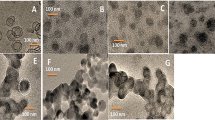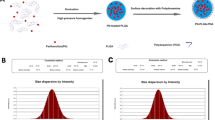Abstract
Purpose
To synthesize pegylated stoichiometrically and structurally well-defined conjugates of fullerene (C60) with doxorubicin (DOX) and investigate their antiproliferative effect against cancer cell lines.
Methods
Stoichiometric (1:1 and 1:2) pegylated conjugates of C60 with DOX were synthesized using the Prato reaction to create fulleropyrrolidines equipped with a carboxyl function for anchoring a polyethylene glycol (PEG) moiety and either a hydroxyl group for attaching one molecule of DOX or a terminal alkyne group for attaching two molecules of DOX through a click reaction. In both conjugates, the DOX moieties are held through a urethane-type bond. Drug release was studied in phosphate buffer (PBS, pH 7.4) and MCF-7 cancer cells lysate. The uptake of the conjugates by MCF-7 cancer cells and their intracellular localization were studied with fluorescence microscopy. The antiproliferative activity of the conjugates was investigated using the WST-1 test.
Results
One or two DOX molecules were anchored on pegylated C60 particles to form DOX-C60-PEG conjugates. Drug liberation from the conjugates was significantly accelerated in the presence of tumor cell lysate compared to PBS. The conjugates could be internalized by MCF-7 cells. DOX from the conjugates exhibited much delayed, compared to free DOX, localization in the nucleus and antiproliferative activity.
Conclusion
Pegylated DOX-C60 conjugates (1:1) and (2:1) with well-defined structure were successfully synthesized and found to exhibit comparable, but with a delayed onset, antiproliferative activity with free DOX against MCF-7 cancer cells. The results obtained justify further investigation of the potential of these conjugates as anticancer nanomedicines.












Similar content being viewed by others
Abbreviations
- DIAD:
-
diisopropyl azodicarboxylate
- DIC:
-
N,N′-diisopropylcarbodiimide
- FCC:
-
Flash Column Chromatography
- HBTU:
-
O-(benzotriazol-1-yl)-N,N,N΄,N΄-tetramethyluronium hexafluorophosphate
- HOSu:
-
N-hydroxysuccinimide
- MeO-PEG-NH2 :
-
amino-polyethylene glycol monomethyl ether
References
Kroto HW, Heath JR, O’Brien SC, Curl RF, Smalley RE. C60: Buckminsterfullerene. Nature. 1985;318:162–3.
Bosi S, Da Ros T, Spalluto G, Prato M. Fullerene derivatives: an attractive tool for biological applications. Eur J Med Chem. 2003;38(11–12):913–23.
Nakamura E, Isobe H. Functionalized fullerenes in water. The first 10 years of their chemistry, biology, and nanoscience. Acc Chem Res. 2003;36(11):807–15.
Hosseini A, Sharifzadeh M, Rezayat SM, Hassanzadeh G, Hassani S, Baeeri M, et al. Benefit of magnesium-25 carrying porphyrin-fullerene nanoparticles in experimental diabetic neuropathy. Int J Nanomedicine. 2010;5:517–23.
Shultz MD, Wilson JD, Fuller CE, Zhang J, Dorn HC, Fatouros PP. Metallofullerene-based nanoplatform for brain tumor brachytherapy and longitudinal imaging in a murine orthotopic xenograft model. Radiology. 2011;261(1):136–43.
Isobe H, Nakanishi W, Tomita N, Inno S, Okayama H, Nakamura E. Nonviral gene delivery by tetraamino fullerene. Mol Pharm. 2006;3(2):124–34.
Fillmore HL, Shultz MD, Henderson SC, Cooper P, Broaddus WC, Chen ZJ, et al. Conjugation of functionalized gadolinium metallofullerenes with IL-13 peptides for targeting and imaging glial tumors. Nanomedicine. 2011;6(3):449–58.
Chaudhuri P, Paraskar A, Soni S, Mashelkar RA, Sengupta S. Fullerenol-cytotoxic conjugates for cancer chemotherapy. ACS Nano. 2009;3(9):2505–14.
Lu F, Haque SA, Yang S-T, Luo PG, Gu L, Kitaygorodskiy A, et al. Aqueous compatible fullerene-doxorubicin conjugates. J Phys Chem C. 2009;113(41):17768–73.
Liu J-H, Cao L, Luo PG, Yang S-T, Lu F, Wang H, et al. Fullerene-conjugated doxorubicin in cells. ACS Appl Mater Interf. 2010;2(5):1384–9.
Zakharian TY, Seryshev A, Sitharaman B, Gilbert BE, Knight V, Wilson LJ. A Fullerene − paclitaxel chemotherapeutic: synthesis, characterization, and study of biological activity in tissue culture. J Am Chem Soc. 2005;127(36):12508–9.
Partha R, Mitchell LR, Lyon JR, Joshi PP, Conyers JL. Buckysomes: fullerene-based nanocarriers for hydrophobic molecule delivery. ACS Nano. 2008;2(9):1950–8.
Hirsch A, Brettreich M. In Fullerenes: Chemistry and Reactions. Weinheim: Wiley VCH; 2005.
WST-1 proliferation assay at http://lifescience.roche.com/shop/products/cell-proliferation-reagent-wst-1.
Burgess A, Vigneron S, Brioudes E, Labbé J-C, Lorca T, Castro A. Loss of human greatwall results in G2 arrest and multiple mitotic defects due to deregulation of the cyclin B-Cdc2/PP2A balance. Proc Natl Acad Sci U S A. 2010;107:12564–9.
Gavet O, Pines J. Progressive activation of CyclinB1-Cdk1 coordinates entry to mitosis. Dev Cell. 2010;18:533–43.
Potapova TA, Sivakumar S, Flynn JN, Li R, Gorbsky GJ. Mitotic progression becomes irreversible in prometaphase and collapses when Wee1 and Cdc25 are inhibited. Mol Biol Cell. 2011;22:1191–206.
Magoulas GE, Garnelis T, Athanassopoulos CM, Papaioannou D, Mattheolabakis G, Avgoustakis K, et al. Synthesis and antioxidative/anti-inflammatory activity of novel fullerene-polyamine conjugates. Tetrahedron. 2012;68(35):7041–9.
Iehl J, Pereira de Freitas R, Nierengarten J-F. Click chemistry with fullerene derivatives. Tetrahedron Lett. 2008;49(25):4063–6.
Heymann D. Solubility of fullerenes C60 and C70 in water. Lunar and Planetary Science. 1996;27:543–4.
Foley S, Crowley C, Smaihi M, Bonfils C, Erlanger BF, Seta P, et al. Cellular localization of a water-soluble fullerene derivative. Biochem Biophys Res Commun. 2002;294(1):116–9.
Moghimi SM, Hunter AC, Murray JC. Long-circulating and target-specific nanoparticles: theory to practice. Pharm Rev. 2001;53(2):283–318.
Maeda H, Wu J, Sawa T, Matsumura Y, Hori K. Tumor vascular permeability and the EPR effect in macromolecular therapeutics: a review. J Control Release. 2000;65(1–2):271–84.
Milic D, Prato M. Fullerene unsymmetrical bis-adducts as models for novel peptidomimetics. Eur J Org Chem. 2010;3:476–83.
Vileno B, Marcoux PR, Lekka M, Sienkiewicz A, Feher I, Forro L. Spectroscopic and photophysical properties of a highly derivatized C60 fullerol. Adv Funct Mater. 2006;16(1):120–8.
Markovic Z, Todorovic-Markovic B, Kleut D, Nikolic N, Vranjes-Djuric S, Misirkic M, et al. The mechanism of cell-damaging reactive oxygen generation by colloidal fullerenes. Biomaterials. 2007;28(36):5437–48.
Trpkovic A, Todorovic-Markovic B, Trajkovic V. Toxicity of pristine versus functionalized fullerenes: mechanisms of cell damage and the role of oxidative stress. Arch Toxicol. 2012;86(12):1809–27.
Zabirnyk O, Yezhelyev M, Seleverstov O. Nanoparticles as a novel class of autophagy activators. Autophagy. 2007;3(3):278–81.
ACKNOWLEDGMENTS AND DISCLOSURES
We wish to thank Dr. N. Eilert, University of Leipsig, for guidance regarding the preliminary biological results, Dr. G. Tsivgoulis, and Dr. K. Andriopoulou, Department of Chemistry, University of Patras, for UV/vis spectra and TGA measurements and related comments, respectively.
Author information
Authors and Affiliations
Corresponding author
Electronic supplementary material
Below is the link to the electronic supplementary material.
ESM 1
Extended structures and UV/Vis, TGA, and 1H-NMR data of final products, experimental procedures and characterization for intermediates as well as information on the solubility of compounds 26, 6c and of a non-pegylated fullerene-DOX conjugate are given. Also, the antiproliferative effect of blank (non-loaded with DOX) pegylated C60 particles (compound 26) is presented. (DOC 471 kb)
Rights and permissions
About this article
Cite this article
Magoulas, G.E., Bantzi, M., Messari, D. et al. Synthesis and Εvaluation of Αnticancer Αctivity in Cells of Novel Stoichiometric Pegylated Fullerene-Doxorubicin Conjugates. Pharm Res 32, 1676–1693 (2015). https://doi.org/10.1007/s11095-014-1566-1
Received:
Accepted:
Published:
Issue Date:
DOI: https://doi.org/10.1007/s11095-014-1566-1




